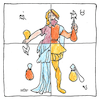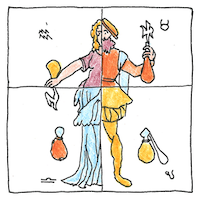Galen
medicine

|
Medical research
Galen of Pergamon was a Greek physician and philosopher who served in the Roman empire. Diagnosis of medical conditions before him relied on divination and mysticism. Galen said, “In order to diagnose, one must observe and reason.” Galen combined the theories of his Greek predecessors, including Hippocrates, with what he could learn of the human body from his own medical practice and from vivisecting and dissecting monkeys and pigs. Galen’s medical theories dominated Western medicine for more than thirteen hundred years.
Humorism
Disease comes from an imbalance of the four humors— yellow bile, blood, phlegm, and black bile, each of which is associated with an organ or two— the spleen, liver, brain and lungs, and the gall bladder. The four humors can wax and wane in response to diet and activity, geography, the four seasons, and the four stages of life. Susceptibility to diseases and psychological conditions depends on a person’s temperament, which is associated with a humor and characterized by a combination of the four qualities— warm, moist, cold, and dry. A good doctor can restore a healthy balance with various drugs and the administration of hot cups, emetics, purges, or bloodletting.
The method
For Freudianism, Jungianism, behaviorism, astrology, tarot, humorism, even phrenology, palmistry, and gazing into crystal balls, the cleverness of the interpretation, not the validity of the theory behind it, can make the method believable. Each of us has a personal philosophy, and who’s to say that it’s erroneous when the method by which it’s applied can depend so much on who applies it.



Galen’s theories were only gradually overthrown, in anatomy by Andreas Vesalius, in the circulation of the blood by William Harvey, and in pathology by Rudolf Virchow. The practice of bloodletting persisted into the nineteeth century.
See also in The book of science:
Readings in wikipedia: